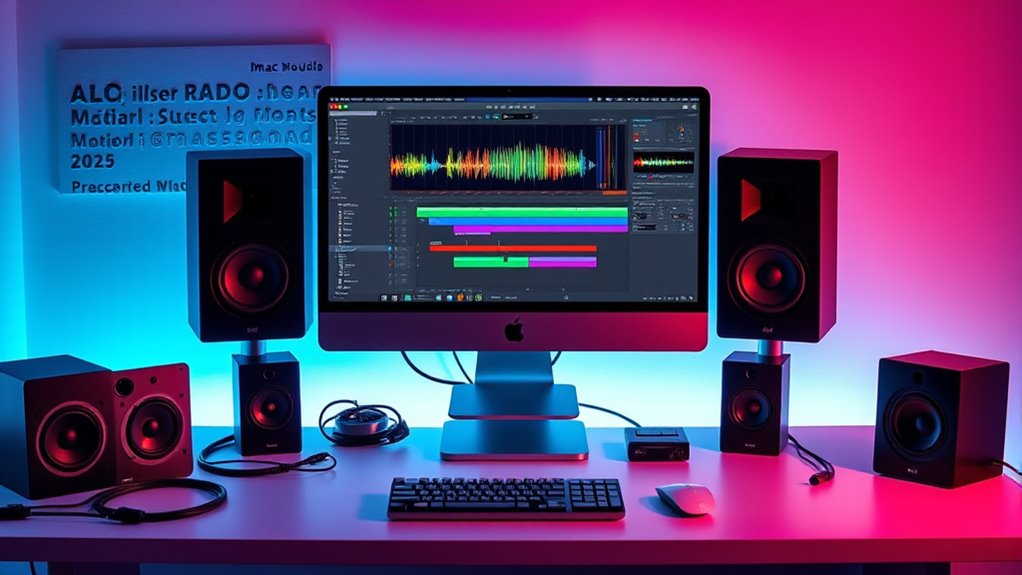If you’re looking for the best Mac Studio models for audio production in 2025, I recommend considering options with high-core CPUs like the M4 Pro and M4 chips, which deliver powerful performance for complex projects. The compact design, extensive connectivity, and fast storage make them ideal for demanding creative work. If you want a detailed breakdown of the top choices and features, keep exploring—there’s more to discover.
Key Takeaways
- Choose models with high-core-count CPUs and GPUs like the M4 Pro for demanding audio production tasks.
- Prioritize compact, quiet designs that fit seamlessly into both home and professional studio setups.
- Opt for extensive connectivity options such as Thunderbolt 4, HDMI, and multiple USB ports for audio hardware compatibility.
- Select storage configurations up to 8TB SSD and consider external drives for large project files.
- Target users needing powerful, energy-efficient machines capable of handling complex editing, mixing, and real-time processing.
Apple Mac mini Desktop Computer with M4 Pro Chip

If you’re looking for a compact yet powerful desktop for audio production, the Apple Mac mini with the M4 Pro chip is an excellent choice. Its small 5×5-inch footprint fits easily next to your monitor, making it perfect for space-constrained setups. Despite its size, it packs a 12-core CPU, 16-core GPU, and up to 24GB of RAM, delivering impressive performance for multitasking and creative workflows. Quiet and cool-running, it won’t distract you with noise. Plus, its seamless integration with macOS and Apple’s ecosystem makes it ideal for music production, editing, and mixing, all while saving desk space.
Best For: creative professionals and home users seeking a compact, powerful desktop for audio production, video editing, and multitasking.
Pros:
- Small, space-efficient design that fits easily next to monitors or in tight spaces.
- Powerful M4 Pro chip with a 12-core CPU and 16-core GPU for demanding workflows.
- Quiet operation and excellent thermal management for distraction-free working.
Cons:
- Limited internal storage options may require external drives or cloud solutions.
- Some users may experience minor setup challenges or monitor compatibility issues.
- Not designed for high-end gaming or extremely intensive graphics workloads.
Apple Mac mini with M4 Chip Desktop Computer

The Apple Mac mini with M4 chip is an excellent choice for audio producers who need a powerful, space-saving desktop that can handle demanding creative workflows. Its compact five-by-five-inch design fits easily on any desk or next to monitors, offering a sleek, modern look. Powered by the M4 chip with a 10-core CPU and GPU, plus up to 32GB of memory, it delivers fast performance for multitasking, mixing, and editing. Supporting multiple displays, including 6K and 8K resolutions, and equipped with extensive ports—Thunderbolt 4, USB-C, HDMI—it guarantees seamless connectivity. Quiet, efficient, and reliable, it’s perfect for home studios or professional setups.
Best For: audio producers and creative professionals seeking a compact, high-performance desktop with extensive connectivity for demanding workflows.
Pros:
- Powerful M4 chip with a 10-core CPU and GPU ensures fast multitasking and efficient workflow handling.
- Compact design with multiple ports (Thunderbolt 4, HDMI, USB-C) for seamless connection to multiple displays and peripherals.
- Quiet operation and reliable performance make it ideal for home studios and professional environments.
Cons:
- Base storage of 256GB SSD may be limiting; external storage may be needed for large projects.
- Limited upgradeability; RAM and storage are not user-accessible for future expansion.
- Slightly higher price point compared to traditional mini PCs with similar specs.
Apple 2024 Mac mini with M4 Chip and 16GB RAM

The Apple 2024 Mac mini with M4 chip and 16GB RAM stands out as an ideal choice for audio producers seeking a compact yet powerful workstation. Its 10-core CPU and GPU deliver fast, smooth performance, perfect for demanding audio tasks. With 16GB of unified memory and a 512GB SSD, it handles large projects effortlessly. The device’s small five-by-five-inch design fits easily into any workspace, while its versatile ports—including Thunderbolt, HDMI, USB-C, and Ethernet—ensure seamless connectivity. Additionally, its integration with macOS and Apple’s ecosystem makes it simple to connect with iPhone, iPad, and other devices, enhancing productivity and workflow.
Best For: audio producers and creative professionals seeking a compact, high-performance workstation with seamless Apple ecosystem integration.
Pros:
- Powerful 10-core CPU and GPU ensure smooth handling of demanding audio projects
- Compact size fits easily into any workspace without sacrificing performance
- Extensive connectivity options like Thunderbolt, HDMI, and Ethernet for versatile setup
Cons:
- Limited internal storage at 512GB may require external drives for large projects
- Higher price point compared to some traditional mini PCs with similar specs
- No dedicated graphics card, which might be a consideration for certain creative tasks
Apple Mac mini Desktop Computer with M4 Chip and 24GB Memory

For those seeking a compact yet powerful solution for audio production, the Apple Mac mini with M4 chip and 24GB of memory stands out as an ideal choice. Its sleek, five-by-five-inch design fits easily on any desk and operates quietly, even under heavy loads. Powered by the M4’s 10-core CPU and GPU, along with hardware-accelerated media engines, it handles demanding audio tasks effortlessly. With 24GB of unified memory and configurable storage up to 2TB, it supports multiple high-resolution displays and professional software. Seamlessly integrating with Apple’s ecosystem, it’s perfect for home studios, giving you power, portability, and precision in a tiny package.
Best For: creative professionals and home audio producers seeking a compact, powerful, and energy-efficient desktop solution that seamlessly integrates with Apple’s ecosystem.
Pros:
- Compact size with sleek design, ideal for limited desk space
- Powerful M4 chip with 10-core CPU and GPU for demanding audio and media tasks
- Quiet operation and excellent energy efficiency, suitable for home studios and professional environments
Cons:
- Limited storage options may require external drives for larger projects
- Some users have experienced minor issues like display wake-up delays
- The high-performance hardware may be overkill for basic tasks, increasing cost for casual users
Factors to Consider When Choosing a Mac Studio for Audio Production

When choosing a Mac Studio for audio production, I consider several key factors to guarantee it meets my needs. These include processing power, storage options, and compatibility with my audio interface. Additionally, I look at expandability, ports, and how well the software runs on the system to make the best choice.
Processing Power Needs
Choosing a Mac Studio with sufficient processing power is essential for smooth audio production, especially when working with large, complex projects. High-core-count processors are vital, as they handle multi-track recording, mixing, and mastering efficiently. Faster CPUs reduce latency during real-time playback and plugin-heavy sessions, ensuring seamless workflow. I recommend at least an 8-core processor for demanding audio software and virtual instruments, as this prevents bottlenecks and improves overall performance. Processing power also impacts how quickly you can render audio files, effects, and complex mixes, saving you valuable time. Adequate CPU capabilities are key to managing high-resolution audio formats and intricate mixing setups without sacrificing stability or speed. In short, investing in a powerful processor keeps your workflow smooth and responsive.
Storage Capacity Options
Selecting the right storage capacity for your Mac Studio is essential to guarantee smooth audio production workflows. With options starting at 512GB and going up to 8TB, you can choose a configuration that matches your project size and future needs. Larger storage options give you ample space for high-resolution audio files, sample libraries, and complex projects without constantly relying on external drives. A higher internal storage capacity also streamlines your workflow, reducing interruptions caused by external data transfers. However, external SSDs can supplement internal storage, offering extra flexibility and faster data access for large datasets. When choosing, consider the size of your current projects and potential growth to avoid performance bottlenecks or running out of space, ensuring seamless creative sessions.
Audio Interface Compatibility
Ensuring your Mac Studio has the right audio interface compatibility is essential for a smooth and reliable audio production setup. First, check that it has Thunderbolt 3 or 4 ports, which are crucial for high-speed, low-latency connections. Confirm that your chosen audio interface supports macOS and is compatible with your specific OS version, preventing driver issues. Review the number and type of USB or Thunderbolt ports to guarantee you can connect all your audio interfaces and peripherals without hassle. Also, verify if the interface requires additional drivers or software, and confirm their compatibility with macOS. Finally, support for professional standards like ASIO or Core Audio is vital to guarantee optimal performance and stability during demanding recording sessions.
Expandability and Ports
When setting up your Mac Studio for audio production, paying attention to expandability and ports can make a big difference in your workflow. Make certain it has enough Thunderbolt 4 and USB-C ports to connect multiple audio interfaces, external drives, and MIDI controllers simultaneously. Check for HDMI and audio input/output options to support monitoring, microphones, and other peripherals. It’s also important to verify if the device offers expandable storage, like multiple SSD bays or high-capacity external drives, to handle large audio libraries. Additionally, look for dedicated audio ports or support for professional-grade equipment to ensure high-quality sound recording and playback. Compatibility with external hardware, multiple displays, and advanced connectivity standards can greatly enhance your creative setup and efficiency.
Software Optimization
Optimized software is vital for making the most of your Mac Studio’s hardware capabilities in audio production. When applications are optimized, they run efficiently, fully leveraging the power of Apple silicon, like the M4 Pro or M4 chips. These chips support native code, which boosts performance and workflow efficiency. Proper optimization also enables hardware-accelerated audio processing, reducing latency and enhancing real-time editing. Compatibility with professional plugins and DAWs depends heavily on whether software is tailored for the specific Mac architecture. Additionally, regular updates and patches are indispensable—they improve stability, security, and overall performance, especially in demanding audio environments. Choosing software that’s well-optimized ensures you get consistent, reliable performance, allowing you to focus on your creative work without technical hiccups.
Noise and Cooling
A quiet workspace is essential for audio production, so choosing a Mac Studio with effective cooling and low noise levels is important. An efficient cooling system helps maintain top performance during demanding audio tasks, preventing overheating and ensuring smooth operation. Advanced thermal management keeps internal components cool, reducing the risk of throttling or lag that can disrupt workflow. Proper ventilation not only safeguards performance but also extends hardware lifespan, which is critical for long-term reliability. Importantly, noise from cooling fans should be minimal to avoid capturing unwanted sounds during sensitive recordings. A Mac Studio with quiet operation allows me to focus on my work without distractions, ensuring clean recordings and consistent performance even under heavy loads.
Display and Monitor Support
Choosing the right display setup is essential for audio production, especially if you rely on multiple monitors for editing and mixing. I look for a Mac Studio that supports high-resolution displays like 6K or 8K, providing sharp visuals for detailed work. It’s important to check the number and types of video output ports—Thunderbolt 4, HDMI, and DisplayPort—to connect various monitor configurations seamlessly. Compatibility with my preferred resolutions and refresh rates ensures smooth playback without display issues. I also consider the maximum number of supported monitors, which facilitates multi-screen workflows for complex projects. Finally, the system must handle high-bandwidth data transfer efficiently, guaranteeing real-time audio and video monitoring across all displays without lag or interruption.
Budget Considerations
When selecting a Mac Studio for audio production, keeping your budget in mind helps guarantee you get the right balance of features and value. Higher-spec models with more RAM and powerful processors cost more, so your budget will influence your hardware choices. It’s important to weigh the initial purchase price against potential future upgrade costs to ensure long-term value. Entry-level configurations are more affordable but might lack the processing power needed for demanding projects. Remember to factor in costs for peripherals, external storage, and software licenses when setting your overall budget. Setting a clear budget upfront helps you prioritize essential features like RAM, storage, and processing power, preventing overspending on unnecessary upgrades and ensuring your investment aligns with your audio production needs.
Frequently Asked Questions
Which Mac Studio Model Offers the Best Upgrade Options for Future Audio Projects?
The Mac Studio with the M2 Ultra chip offers the best upgrade options for future audio projects. I recommend this model because it provides exceptional processing power, extensive RAM options, and multiple Thunderbolt ports for expandability. As my projects grow more complex, I know I can upgrade storage and connect additional peripherals easily. This ensures my setup remains future-proof, allowing me to handle demanding audio workflows with ease.
How Does Thermal Management Impact Performance During Intensive Audio Production Sessions?
Thermal management directly impacts performance during intense audio sessions by preventing overheating, which can cause your Mac to throttle performance. I notice that when my Mac Studio’s cooling system works efficiently, I get smoother workflows and fewer crashes. Good airflow and a robust cooling system allow the processor to run at peak speeds longer. If thermal management is poor, it can slow down your projects and disrupt your creative flow.
Are There Specific Ports or Connectivity Features Crucial for Professional Audio Hardware?
Think of ports as the gateways to your creative universe. For professional audio hardware, Thunderbolt 4 and USB-C are essential—they’re like highways for high-speed data, ensuring smooth, lag-free recording. An SD card slot is a bonus for quick transfers of samples or backups. I always look for these connectivity features on my Mac Studio because they keep my workflow seamless and my studio running at full throttle.
What Are the Differences in Power Consumption Among These Mac Studio Models?
The power consumption varies among Mac Studio models, with newer versions generally being more efficient. I’ve noticed that models with the M2 Ultra chip tend to use slightly more power than those with the M2 Max, but they’re still energy-efficient overall. If you’re concerned about energy use, I recommend checking the specific specs for each model, as Apple provides detailed power consumption data to help you choose wisely.
How Do Software Compatibility Concerns Influence Mac Studio Selection for Audio Work?
Software compatibility is vital when choosing a Mac Studio for audio work because I want seamless performance without surprises. I always check if my favorite DAWs and plugins are optimized for the latest macOS and hardware. If a model isn’t fully compatible, it could cause headaches or limit my creative flow. So, I prioritize compatibility to guarantee my setup runs smoothly and I can focus on making music, not troubleshooting.
Conclusion
Choosing the right Mac Studio is like finding the perfect brush for your masterpiece—each model offers unique power and precision. Whether you’re slicing through complex tracks or crafting intricate soundscapes, these options give you the strength to bring your audio visions to life. Trust your needs, and let your creativity flow freely. With the right Mac, you’ll have the tools to turn your ideas into a symphony of success.









